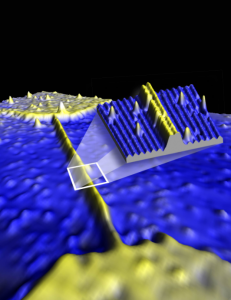Quantum leap: The world's thinnest silicon wire

MELBOURNE -- A new study published last week in the journalScience has unveiled the creation of the world's thinnest wire, measuring only four atoms wide and one atom tall.
The breakthrough study showed that the fabricated wires could hold the same electrical current carrying capability of copper, and that the electrical resistivity of the wires (I~0.3 milliohm-centimeters) did not depend on the wire width.
The wires, about 10,000 times smaller than a strand of human hair, were developed by Mr Bent Weber from the Centre for Quantum Computation and Communication Technology (CQCCT) at the University of New South Wales.
Mr Weber, a PhD student, was assisted by his supervisor Professor Michelle Simmons, a leading Australian scientist, along with researchers from the University of Melbourne and Purdue University, Indiana.
The research team used scanning tunnelling microscopy to create the wires, a technique which enabled them to place chains of phosphorous atoms within a silicon crystal.
“It is extraordinary to show that such a basic law still holds even when constructing a wire from the fundamental building blocks of nature -- atoms,” Mr Weber said.

"It shows that we can make interconnects in silicon all the way to the level of atomic rows,” Prof. Simmons said. “We are using the same materials as industry, just phosphorus dopant atoms in silicon, but using different methods of fabrication to show that there is no fundamental barrier in terms of resistivity to taking Moore’s law all the way to the atomic-level."
Prof. Simmons explained that the discovery is significant on many levels including its practical uses in the semiconductor industry.
As computers get smaller, so do their components, and the study has proven that devices can be downscaled to an atomic level while still conducting with the same resistivity.
Even more exciting is the possibility of the world’s first practical quantum computer, a computer that would enable super fast database searching, encryption and decryption of information (coding).
Researchers at the CQCCT have already started to simulate quantum systems such as a molecular hydrogen using the latest photonic quantum computer technology (Nature Chemistry 2, 106 (2010)).
Although the idea of a supercomputer is still at least a decade away, the fabrication of the nanowire is a major advancement for the science community.
Prof. Simmons said that applications of a quantum computer are vast. “In the long term, any calculation where there is a large number of variables or data would stand to benefit, such as weather forecasting, economic modeling, and modeling complex systems," she said.
Photo: Bent Weber
Video: Mary O'Malley, Lee Henderson, Tony Melov & Tolmie MacRae
Updated by author 13 January 8.50am EST.
This post was originally published on Smartplanet.com